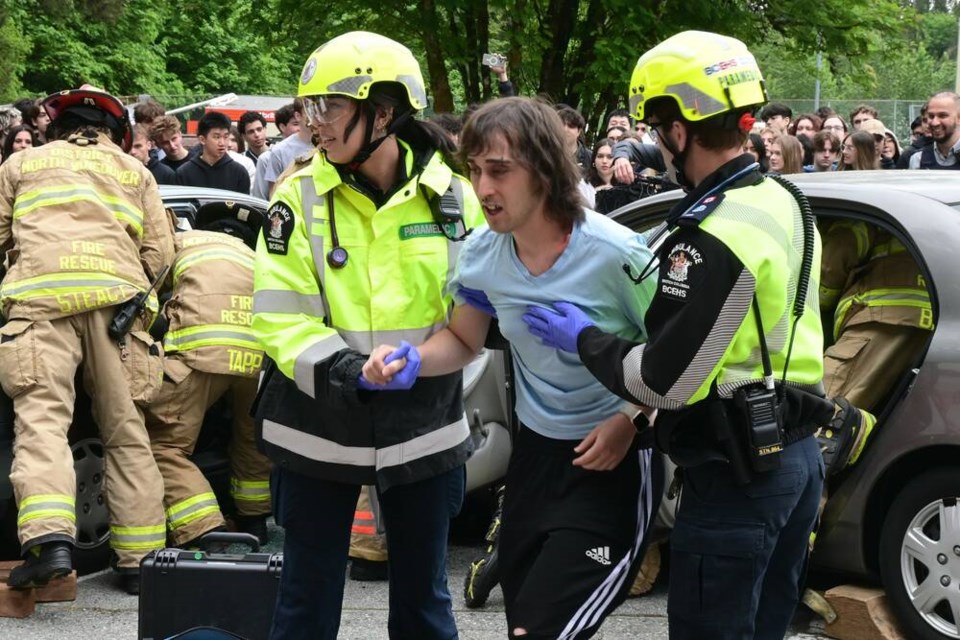It was a striking experience for dozens of North Vancouver high school students as they saw a mock crash unfold at Windsor Secondary Thursday morning.
Police, firefighters and paramedics quickly arrived on scene as part of a fake reenactment responding to a car crash involving drama students from the high school.
The mock crash is part of an annual educational event hosted by North Vancouver RCMP to teach students the risk of dangerous driving and making the right decisions when behind the wheel, but also showing the real, horrifying experiences of what can happen when not paying attention.
“What we’re trying to prevent is kids from getting behind the wheel and dying,” said Cpl. Mansoor Sahak, media relations officer for North Vancouver RCMP. “It’s a real-life situation that we’re trying to demonstrate to these kids.”
The mock crash began with two young drivers involved in a collision. Shortly after, a student called 911, with District of North Vancouver Fire and Rescue Services, BC Emergency Health Services and local Mounties arriving quickly and getting to work, just as they would do at a real crash scene.
Firefighters helped student actors get out of the vehicles, which were props from a previous, real collision, using a Jaws of Life tool to cut car doors. Then fire crews and paramedics put them on stretchers to take the actors to Lions Gate Hospital. One of the student drivers was impaired and arrested on scene.
ICBC stats reveal that, on average, 28 youth ages 16 to 21 are killed in crashes every year in B.C., a number Sahak said first responders want to bring down.
“We’re trying to bring that number down, bring it to zero, because they’re preventable tragedies,” Sahak said. “If we can demonstrate to them what we’re doing here, and if they could take away something from that, then we’ve done our jobs.”
ICBC data also notes contributing factors for crashes involving drivers age 16 to 21 resulting in injuries or death, including 22 per cent with speeding drivers, 13 per cent with impaired drivers and 14 per cent with distracted drivers.
Driver inexperience, overestimating ability, driving without due care and thrill-seeking also play a role in the rate of youth crashes, according to ICBC’s website.
Safety messages important heading into grad season
Brian Twaites, paramedic public information officer with British Columbia Emergency Health Services, said messages spread through mock crashes carry a domino effect.
“These students will go home, they’ll talk to their family, relatives, friends about this scenario that they watched today,” Twaites said. “So that also helps spread the word about distracted driving and the dangers involved."
The information officer said they usually stage mock crashes to coincide with grad season, but this year it worked out as another reminder to drive safely during long weekends.
On top of the mock crash serving a safety reminder, he said it helps provide a good training exercise when first responders need to respond to real-life scenarios.
“Our paramedics are working closely with the fire department on patient care and extrication,” he said. “So, it’s a very good training exercise for our organization and the others as well.”
“But really it’s about education for the students,” he added. “If one student goes home and realizes, ‘Hey, this isn’t a safe thing to do … to me, that’s a complete success of this exercise.”
Abby Luciano is the Indigenous and civic affairs reporter for the North Shore News. This reporting beat is made possible by the Local Journalism Initiative.
https://bsky.app/profile/abbyluciano.bsky.social
Want to stay updated on North Vancouver and West Vancouver news? Sign up for our free daily newsletter.



